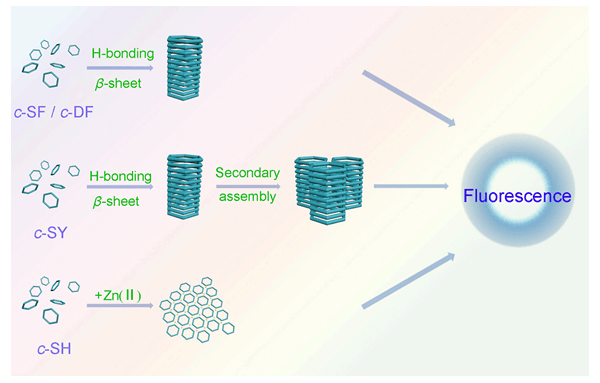[1] Wang, J.; Zou, Q.-L.; Yan, X.-H. Acta Chim. Sinica 2017, 75, 933(in Chinese). (王娟, 邹千里, 闫学海, 化学学报, 2017, 75, 933.)
[2] Yan, X.; Zhu, P.; Li, J. Chem. Soc. Rev. 2010, 39, 1877.
[3] Wang, J.-X.; Qin, S.-Y.; Cai, T.-T.; Zhang, X.-Z.; Zhuo, R.-X. Chem. J. Chin. Univ. 2014, 36, 201(in Chinese). (王建勋, 秦四勇, 蔡腾腾, 张先正, 卓仁禧, 高等学校化学学报, 2014, 36, 201.)
[4] Han, S.; Cao, S.; Wang, Y.; Wang, J.; Xia, D.; Xu, H.; Zhao, X.; Lu, J. Chem.-Eur. J. 2011, 17, 13095.
[5] Li, Q.; Jia, Y.; Li, J.-B. Acta Chim. Sinica 2019, 77, 1173(in Chinese). (李琦, 贾怡, 李峻柏, 化学学报, 2019, 77, 1173.)
[6] MaassenVanDenBrink, A.; Terwindt, G. M.; van den Maagdenberg, A M. J. M. Genome Med. 2018, 10, 10.
[7] Inaba, H.; Matsuura, K. Chem. Rec. 2019, 19, 843.
[8] Apter, B.; Lapshina, N.; Handelman, A.; Rosenman, G. J. Pept. Sci. 2019, 25, 3164.
[9] Yang, W.-T.; Guo, W.-S.; Zhang, B.-B.; Chang, J. Acta Chim. Sinica 2014, 72, 1209(in Chinese). (杨维涛, 郭伟圣, 张兵波, 常津, 化学学报, 2014, 72, 1209.)
[10] Wang, Z.-Y.; Cai, Y.-B.; Yi, L.-N.; Gao, J.; Yang, Z.-M. Chin. J. Chem. 2017, 35, 1057.
[11] Kwak, J.; Lee, S. Y. Langmuir 2013, 29, 4477.
[12] Elmes, R. B. P.; Jolliffe, K. A. Chem. Commun. 2015, 51, 4951.
[13] Prasad, C. Peptides 1995, 16, 151.
[14] Benedetti, E.; Corradini, P.; Pedone, C. J. Phys. Chem. 1969, 73, 2891.
[15] Corey, R. B. J. Am. Chem. Soc. 1938, 60, 1598.
[16] Manchineella, S.; Govindaraju, T. ChemPlusChem 2017, 82, 88.
[17] Govindaraju, T. Supramol. Chem. 2011, 23, 759.
[18] Govindaraju, T.; Pandeeswar, M.; Jayaramulu, K.; Jaipuria, G.; Atreya, H. S. Supramol. Chem. 2011, 23, 487.
[19] Palmore, G. T. R.; Luo, T. J. M.; McBride-Wieser, M. T.; Picciotto, E. A.; Reynoso-Paz, C. M. Chem. Mater. 1999, 11, 3315.
[20] Di Blasio, B.; Pavone, V.; Nastri, F.; Isernia, C.; Saviano, M.; Pedone, C.; Cucinotta, V.; Impellizzeri, G.; Rizzarelli, E.; Vecchio, G. Natl. Acad. Sci. U. S. A. 1992, 89, 7218.
[21] Bergeron, R. J.; Phanstiel IV, O.; Yao, G. W.; Milstein, S.; Weimar, W. R. J. Am. Chem. Soc. 1994, 116, 8479.
[22] Bellezza, I.; Peirce, M. J.; Minelli, A. Trends Mol. Med. 2014, 20, 551.
[23] González, O.; Ortíz-Castro, R.; Díaz-Pérez, C.; Díaz-Pérez, A. L.; Magaña-Dueñas, V.; López-Bucio, J.; Campos-García, J. Microb. Ecol. 2017, 73, 616.
[24] Nishanth Kumar, S.; Dileep, C.; Mohandas, C.; Nambisan, B.; Ca, J. J. Pept. Sci. 2014, 20, 173.
[25] Van der Merwe, E.; Huang, D.; Peterson, D.; Kilian, G.; Milne, P. J.; Van de Venter, M.; Frost, C. Peptides 2008, 29, 1305.
[26] Yang, M.; Yuan, C.; Shen, G.; Chang, R.; Xing, R.; Yan, X. J. Colloid Interface Sci. 2019, 557, 458.
[27] Tao, K.; Makam, P.; Aizen, R.; Gazit, E. Science 2017, 358, 9756.
[28] Tao, K.; Fan, Z.; Sun, L.; Makam, P.; Tian, Z.; Ruegsegger, M.; Shaham-Niv, S.; Hansford, D.; Aizen, R.; Pan, Z.; Galster, S.; Ma, J.-J.; Yan, F.; Si, M.-S.; Qu, S.-N.; Zhang, M.-J.; Gazit, E.; Li, J.-B. Nat. Commun. 2018, 9, 3217.
[29] Seo, M. J.; Song, J.; Kantha, C.; Khazi, M. I.; Kundapur, U.; Heo, J. M.; Kim, J. M. Langmuir 2018, 34, 8365.
[30] Yang, M.; Xing, R.; Shen, G.; Yuan, C.; Yan, X. Colloids Surf., A 2019, 572, 259.
[31] Zong, Q.-Y.; Geng, H.-M.; Wang, L.; Ye, L.; Zhang, A.-Y.; Shao, Z.-Q.; Feng, Z.-G. Acta Chim. Sinica 2015, 73, 423(in Chinese). (宗倩颖, 耿慧敏, 王璐, 叶霖, 张爱英, 邵自强, 冯增国, 化学学报, 2015, 73, 423.)
[32] Tucker, M. J.; Oyola, R.; Gai, F. Biopolymers 2006, 83, 571.
[33] Fan, Z.; Sun, L.; Huang, Y.; Wang, Y.; Zhang, M. Nat. Nanotechnol. 2016, 11, 388.
[34] Wang, C.; Zhang, L.; Yang, J.; Yang, J.; Wang, D.; Sun, Y.; Wang, J. Appl. Surf. Sci. 2018, 453, 173.
[35] Wang, J.; Zhang, L.; Yang, J.; Yan, H.; Li, X.; Wang, C.; Wang, D.; Sun, Y.; Xu, H. Langmuir 2019, 35, 5617.
[36] Zou, R.; Wang, Q.; Wu, J.; Schmuck, C.; Tian, H. Chem. Soc. Rev. 2015, 44, 5200.
[37] Faller, P.; Hureau, C.; Berthoumieu, O. Inorg. Chem. 2013, 52, 12193.
[38] Ren, X.; Zou, Q.; Yuan, C.; Chang, R.; Xing, R.; Yan, X. Angew. Chem., Int. Ed. 2019, 58, 5872. |
